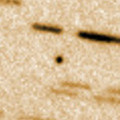
|
It brightened up to 11.6 mag in mid October (Oct. 13, Chris Wyatt). It passed the perihelion on Oct. 27. It will not be observable after this.
Date(TT) R.A. (2000) Decl. Delta r Elong. m1 Best Time(A, h)
Nov. 4 14 56.17 -5 10.3 1.226 0.318 11 7.2 18:29 ( 89, -8)
Nov. 11 15 41.92 -7 33.2 1.438 0.528 13 10.2 18:24 ( 84, -5)
|
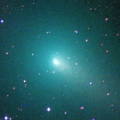
|
Now it is bright as 9.2 mag (Nov. 2, Maik Meyer). In the Northern Hemisphere, it stays observable in excellent condition for a long time. In the Southern Hemisphere, it will never be observable again after this. It started fading before the peirhelion passage.
Date(TT) R.A. (2000) Decl. Delta r Elong. m1 Best Time(A, h)
Nov. 4 4 54.91 71 45.9 0.765 1.525 119 8.8 2:04 (180, 53)
Nov. 11 4 50.89 77 11.7 0.804 1.546 118 9.1 1:33 (180, 48)
|
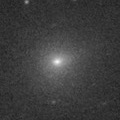
|
Now it is bright as 10.6 mag (Oct. 23, Juan Jose Gonzalez). It stays 10 mag until December. It is observable in good condition in the Northern Hemisphere. It locates very low for a long time in the Southern Hemisphere.
Date(TT) R.A. (2000) Decl. Delta r Elong. m1 Best Time(A, h)
Nov. 4 11 22.41 11 32.4 1.477 1.218 54 10.7 4:57 (283, 37)
Nov. 11 11 49.98 9 24.5 1.465 1.209 54 10.5 5:03 (286, 37)
|
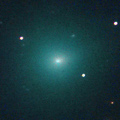
|
Now it is very bright as 10.2 mag (Oct. 23, Juan Jose Gonzalez). It stays 11 mag until winter. It is observable in good condition in the Northern Hemisphere. It locates low in the Southern Hemisphere.
Date(TT) R.A. (2000) Decl. Delta r Elong. m1 Best Time(A, h)
Nov. 4 10 24.01 13 42.6 1.398 1.391 68 11.3 4:57 (292, 49)
Nov. 11 10 47.63 12 22.8 1.365 1.385 69 11.2 5:03 (296, 50)
|

|
It brightened up to 7.1 mag from May to June (June 21, Juan Jose Gonzalez). Now it is fading. It has already faded down to 12.2 mag (Oct. 19, Chris Wyatt). In the Southern Hemisphere, it stays observable for a long time after this. It will never be observable again in the Northern Hemisphere.
Date(TT) R.A. (2000) Decl. Delta r Elong. m1 Best Time(A, h)
Nov. 4 18 4.15 -56 36.5 2.880 2.480 56 11.8 18:29 ( 25,-11)
Nov. 11 18 26.74 -56 55.5 2.987 2.544 54 12.0 18:24 ( 25,-11)
|
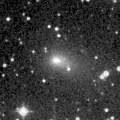
|
Now it is 12.8 mag (Oct. 30, Chris Wyatt). It will stay bright as 11 mag for a long time from winter to next spring. In the Southern Hemisphere, it stays observable in good condition until next February. In the Northern Hemispehre, it stays observable for a long time after this until the comet fades out.
Date(TT) R.A. (2000) Decl. Delta r Elong. m1 Best Time(A, h)
Nov. 4 5 29.20 0 55.4 2.471 3.249 135 12.1 2:37 ( 0, 56)
Nov. 11 5 24.25 1 53.6 2.366 3.207 142 11.9 2:05 ( 0, 57)
|

|
Now it is very bright as 11.5 mag (Oct. 22, Juan Jose Gonzalez).
Date(TT) R.A. (2000) Decl. Delta r Elong. m1 Best Time(A, h)
Nov. 4 21 6.79 -14 24.6 5.668 5.811 93 13.5 18:29 ( 5, 41)
Nov. 11 21 8.75 -14 13.4 5.780 5.809 86 13.5 18:24 ( 12, 40)
|
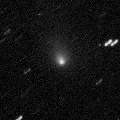
|
It brightened very rapidly from July to August. Now it is very bright as 14.1 mag (Sept. 27, Chris Wyatt). It is observable in excellent condition in the Southern Hemisphere. It stays low for a while in the Northern Hemisphere.
Date(TT) R.A. (2000) Decl. Delta r Elong. m1 Best Time(A, h)
Nov. 4 23 53.80 -33 31.0 1.971 2.585 117 13.8 20:58 ( 0, 22)
Nov. 11 23 52.22 -32 11.1 2.011 2.558 112 13.8 20:29 ( 0, 23)
|
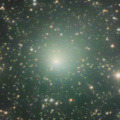
|
It brightened up to 10 mag from spring to summer. Now it is fading. It has already faded down to 12.7 mag (Oct. 26, Seiichi Yoshida). It is observable in excellent condition in the Southern Hemisphere. It locates low in the Northern Hemisphere.
Date(TT) R.A. (2000) Decl. Delta r Elong. m1 Best Time(A, h)
Nov. 4 20 34.61 -29 7.2 1.839 1.969 82 13.8 18:29 ( 12, 25)
Nov. 11 20 50.11 -27 45.9 1.942 2.004 78 14.0 18:24 ( 14, 26)
|
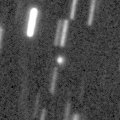
|
Now it is 13.7 mag (Sept. 22, Sandor Szabo). It is expected to brighten up to 12 mag from 2018 to 2019. In the Northern Hemisphere, it stays observable in good condition while the comet will be brightening gradually. In the Southern Hemisphere, it is not observable until 2018 October.
Date(TT) R.A. (2000) Decl. Delta r Elong. m1 Best Time(A, h)
Nov. 4 15 8.56 47 11.1 4.077 3.731 62 14.6 18:29 (133, 23)
Nov. 11 15 12.49 47 8.5 4.000 3.684 64 14.4 18:24 (134, 20)
|
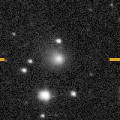
|
Now it is 14.4 mag (Oct. 9, Yasukazu Ikari). It is expected to brighten up to 10 mag in summer in 2018. In the Northern Hemisphere, it stays observable until 2018 summer while the comet will be brightening. In the Southern Hemisphere, it is hardly observable in 2017, but it will be observable in good condition in 2018.
Date(TT) R.A. (2000) Decl. Delta r Elong. m1 Best Time(A, h)
Nov. 4 17 25.55 19 34.9 4.252 3.760 54 14.5 18:29 ( 90, 36)
Nov. 11 17 30.86 17 52.0 4.256 3.704 50 14.5 18:24 ( 91, 31)
|
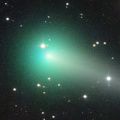
|
It brightened up to 6.2 mag in April (Apr. 7, Juan Jose Gonzalez). Now it is fading rapidly. It has already faded down to 13.6 mag (Oct. 17, Thomas Lehmann). It stays observable for a long time after this.
Date(TT) R.A. (2000) Decl. Delta r Elong. m1 Best Time(A, h)
Nov. 4 3 17.72 19 25.9 1.822 2.803 169 14.5 0:26 ( 0, 75)
Nov. 11 3 10.01 18 42.5 1.893 2.883 178 14.8 23:46 ( 0, 74)
|
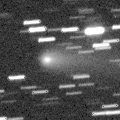
|
It brightened up to 12.2 mag in August (Aug. 21, Juan Jose Gonzalez). It is fading now. It has already faded down to 14.0 mag (Oct. 1, Michael Jager).
Date(TT) R.A. (2000) Decl. Delta r Elong. m1 Best Time(A, h)
Nov. 4 8 15.28 9 55.0 1.398 1.818 97 14.6 4:57 (346, 64)
Nov. 11 8 19.36 9 58.4 1.376 1.874 103 14.8 4:59 ( 0, 65)
|
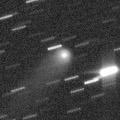
|
Now it is 13.6 mag (Oct. 23, T. Ikemura, H. Sato). It will be observable at 14 mag for a long time from 2017 to 2018. In the Southern Hemisphere, it will be hardly observable after this. It will be extremely low from November to December in the Northern Hemisphere.
Date(TT) R.A. (2000) Decl. Delta r Elong. m1 Best Time(A, h)
Nov. 4 16 11.64 18 54.0 4.536 3.849 41 14.7 18:29 ( 99, 20)
Nov. 11 16 13.83 18 57.7 4.538 3.834 40 14.7 18:24 (102, 16)
|
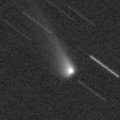
|
Now it is 14.4 mag (Oct. 27, Catalina Sky Survey). It stays observable at 15-16 mag for a long time from 2017 to 2018.
Date(TT) R.A. (2000) Decl. Delta r Elong. m1 Best Time(A, h)
Nov. 4 0 54.06 12 20.0 3.363 4.282 155 15.0 21:58 ( 0, 67)
Nov. 11 0 45.07 10 18.1 3.425 4.278 145 15.0 21:22 ( 0, 65)
|
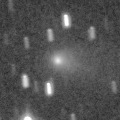
|
Now it is 15.0 mag (Oct. 30, D. Buczynski). It brightened rapidly. It is observable at 15 mag in autumn in good condition in the Northern Hemisphere. It locates low in the Southern Hemisphere.
Date(TT) R.A. (2000) Decl. Delta r Elong. m1 Best Time(A, h)
Nov. 4 5 42.04 35 31.9 1.171 1.991 133 15.0 2:50 (180, 90)
Nov. 11 5 41.42 36 41.9 1.146 2.011 140 15.0 2:22 (180, 88)
|
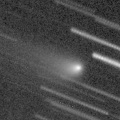
|
Now it is 15.9 mag (Oct. 9, T. Ikemura, H. Sato). It will be fading after this.
Date(TT) R.A. (2000) Decl. Delta r Elong. m1 Best Time(A, h)
Nov. 4 19 6.65 -15 47.4 3.084 2.809 64 15.1 18:29 ( 39, 30)
Nov. 11 19 5.06 -16 29.8 3.237 2.828 57 15.2 18:24 ( 44, 26)
|
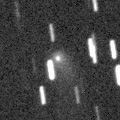
|
Now it is 13.7 mag (Oct. 13, Juan Jose Gonzalez). In the Northern Hemisphere, it stays 15 mag until winter, and it is observable in excellent condition. It is not observable at all after this in the Southern Hemisphere.
Date(TT) R.A. (2000) Decl. Delta r Elong. m1 Best Time(A, h)
Nov. 4 19 55.64 65 59.1 2.911 3.233 99 15.3 18:29 (164, 56)
Nov. 11 19 49.90 64 53.3 2.952 3.243 98 15.4 18:24 (159, 55)
|

|
Now it is 15.6 mag (Oct. 25, Yasukazu Ikari). It stays observable at 16 mag unil the end of 2017.
Date(TT) R.A. (2000) Decl. Delta r Elong. m1 Best Time(A, h)
Nov. 4 3 29.56 -0 20.3 5.207 6.146 159 15.5 0:38 ( 0, 55)
Nov. 11 3 27.01 -0 38.5 5.229 6.175 161 15.5 0:08 ( 0, 54)
|
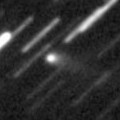
|
Now it is 14.7 mag (Oct. 30, Chris Wyatt). It stays 15 mag until winter. In the Southern Hemisphere, it stays observable in excellent condition until spring in 2018. In the Northern Hemisphere, it stays unobservable until 2018.
Date(TT) R.A. (2000) Decl. Delta r Elong. m1 Best Time(A, h)
Nov. 4 1 43.00 -75 58.1 1.914 2.131 88 15.7 22:46 ( 0,-21)
Nov. 11 1 33.27 -73 32.2 1.892 2.103 87 15.6 22:09 ( 0,-18)
|
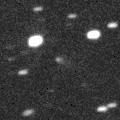
|
Now it is 16.6 mag (Oct. 11, Catalina Sky Survey). It will approach to Earth down to 0.2 a.u., and to Sun down to 0.6 a.u., and it is expected to brighten up to 9 mag from winter to spring. In the Northern Hemisphre, it stays observable in good condition until January, but it will be extremely low after that. In the Southern Hemisphere, it is not observable from January to mid March, but it stays observable in good condition except for that period.
Date(TT) R.A. (2000) Decl. Delta r Elong. m1 Best Time(A, h)
Nov. 4 8 44.48 -4 11.7 1.893 2.090 86 16.1 4:57 (339, 49)
Nov. 11 8 48.87 -3 57.7 1.683 1.989 92 15.6 5:03 (350, 51)
|

|
Now it is 17.1 mag (Oct. 3, ATLAS-HKO, Haleakala). It will be unobservable in late October in the Northerm Hemisphere, or in late November in the Southern Hemisphere.
Date(TT) R.A. (2000) Decl. Delta r Elong. m1 Best Time(A, h)
Nov. 4 17 39.63 -27 57.1 3.540 2.911 44 15.7 18:29 ( 47, 8)
Nov. 11 17 51.82 -28 5.8 3.603 2.913 39 15.7 18:24 ( 49, 6)
|
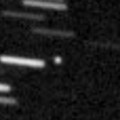
|
Now it is 16.4 mag (Oct. 29, Katsumi Yoshimoto). It will approach to Earth down to 0.07 a.u. in mid December, and it will brighten up to 10 mag. In the Northern Hemisphere, it stays observable in excellent condition until mid December. In the Southern Hemisphere, it stays low.
Date(TT) R.A. (2000) Decl. Delta r Elong. m1 Best Time(A, h)
Nov. 4 7 2.86 34 39.9 0.850 1.577 117 16.3 4:10 ( 0, 90)
Nov. 11 7 5.74 35 12.8 0.704 1.501 123 15.8 3:46 (180, 90)
|
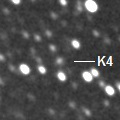
|
Now it is 15.0 mag (Oct. 10, T. Ikemura, H. Sato). It stays 16 mag for a long time until summer in 2018. In the Southern Hemisphere, it stays observable in excellent condition until autumn. It locates low in the Northern Hemisphere.
Date(TT) R.A. (2000) Decl. Delta r Elong. m1 Best Time(A, h)
Nov. 4 18 29.47 -24 30.5 3.169 2.727 55 15.9 18:29 ( 41, 18)
Nov. 11 18 41.95 -23 47.9 3.222 2.711 51 15.9 18:24 ( 43, 17)
|
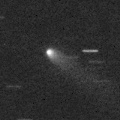
|
Now it is 15.7 mag (Oct. 30, Catalina Sky Survey). It will be fading after this, and it will be fainter than 18 mag in March.
Date(TT) R.A. (2000) Decl. Delta r Elong. m1 Best Time(A, h)
Nov. 4 1 3.24 17 38.1 1.999 2.940 157 15.9 22:07 ( 0, 73)
Nov. 11 0 59.38 17 28.2 2.051 2.951 150 16.0 21:36 ( 0, 73)
|

|
Now it is 16.7 mag (Nov. 2, A. Diepvens). It will be observable at 15 mag in good condition from winter to spring.
Date(TT) R.A. (2000) Decl. Delta r Elong. m1 Best Time(A, h)
Nov. 4 11 11.70 11 21.5 3.986 3.549 57 16.0 4:57 (285, 39)
Nov. 11 11 18.87 10 47.0 3.896 3.547 62 16.0 5:03 (291, 43)
|

|
Appearing in the morning sky. It stays 16-17 mag for a long time from 2016 to 2019. It stays near by the equator.
Date(TT) R.A. (2000) Decl. Delta r Elong. m1 Best Time(A, h)
Nov. 4 10 25.51 4 11.7 9.937 9.561 65 16.1 4:57 (302, 43)
Nov. 11 10 27.63 4 5.1 9.831 9.563 71 16.1 5:03 (310, 48)
|
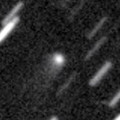
|
Now it is 16.4 mag (Oct. 26, Purple Mountain Observatory, XuYi Station). It stays 16 mag for a long time from 2017 to 2018. It is observable in excellent condition in the Northern Hemisphere. It locates very low in the Southern Hemisphere.
Date(TT) R.A. (2000) Decl. Delta r Elong. m1 Best Time(A, h)
Nov. 4 9 17.66 23 5.2 5.292 5.330 86 16.4 4:57 (296, 67)
Nov. 11 9 17.04 24 2.8 5.164 5.329 94 16.3 5:03 (310, 74)
|
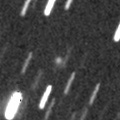
|
Now it is 17.1 mag (Oct. 27, Yuji Ohshima). It stays observable at 16 mag for a long time until summer in 2018. It is observable in good condition in the Northern Hemisphere in 2017, and in the Southern Hemisphere in 2018.
Date(TT) R.A. (2000) Decl. Delta r Elong. m1 Best Time(A, h)
Nov. 4 5 16.34 62 58.7 1.454 2.178 124 16.7 2:27 (180, 62)
Nov. 11 4 3.57 65 26.6 1.332 2.116 130 16.4 0:49 (180, 60)
|
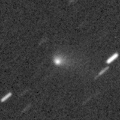
|
Now it is 15.9 mag (Nov. 2, ATLAS-HKO, Haleakala). Return of a new periodic comet which brightened up to 13 mag in 2004. It will be observable in excellent condition in autumn. It was expected to brighten up to 14 mag, if the comet is as bright as when it was discovered. But actually, it is much fainter than expected.
Date(TT) R.A. (2000) Decl. Delta r Elong. m1 Best Time(A, h)
Nov. 4 2 28.83 9 12.0 0.739 1.729 173 16.4 23:33 ( 0, 64)
Nov. 11 2 23.68 10 33.8 0.757 1.738 168 16.5 23:00 ( 0, 66)
|
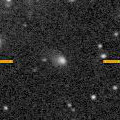
|
Now it is 16.4 mag (Oct. 26, D. Buczynski). It is expected to brighten up to 13-14 mag from 2018 to 2019. In the Northern Hemisphere, it stays observable in good condition for a long time. In the Southern Hemisphere, it is not observable until summer in 2018.
Date(TT) R.A. (2000) Decl. Delta r Elong. m1 Best Time(A, h)
Nov. 4 18 28.95 49 55.8 5.184 5.154 82 16.7 18:29 (129, 55)
Nov. 11 18 31.51 48 20.3 5.183 5.109 80 16.7 18:24 (126, 52)
|
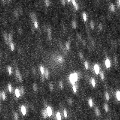
|
It brightened up to 13.5 mag in July (July 5, Chris Wyatt). But it is fading after that, even before the perihelion passage. It has already faded down to 16.8 mag (Oct. 29, ATLAS-MLO, Mauna Loa). It is observable in excellent condition in the Southern Hemisphere. It locates somewhat low in the Northern Hemisphere.
Date(TT) R.A. (2000) Decl. Delta r Elong. m1 Best Time(A, h)
Nov. 4 20 21.21 -15 9.9 1.881 2.008 82 16.7 18:29 ( 19, 38)
Nov. 11 20 34.22 -14 2.8 1.960 2.018 78 16.9 18:24 ( 22, 38)
|
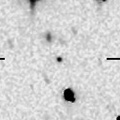
|
Now it is 16.6 mag (Oct. 24, Catalina Sky Survey). It will be observable at 16.5 mag in good condition in winter.
Date(TT) R.A. (2000) Decl. Delta r Elong. m1 Best Time(A, h)
Nov. 4 9 29.72 2 10.2 2.750 2.718 77 16.7 4:57 (319, 50)
Nov. 11 9 36.69 0 25.0 2.684 2.735 82 16.7 5:03 (330, 51)
|
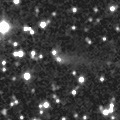
|
Now it is 16.9 mag (Nov. 2, A. Diepvensy). In the Northern Hemisphere, it will be observable at 17 mag in excellent condition from autumn to winter. It locates low in the Southern Hemisphere.
Date(TT) R.A. (2000) Decl. Delta r Elong. m1 Best Time(A, h)
Nov. 4 5 44.33 34 32.9 2.361 3.130 133 16.8 2:52 ( 0, 90)
Nov. 11 5 42.38 34 58.8 2.316 3.145 140 16.7 2:23 ( 0, 90)
|

|
Now it is 16.1 mag (Oct. 29, N. James). It stays 16 mag from 2016 to 2017. In the Northern Hemisphere, it stays observable in good condition for a long time. In the Southern Hemisphere, it will never be observable again.
Date(TT) R.A. (2000) Decl. Delta r Elong. m1 Best Time(A, h)
Nov. 4 18 23.90 59 48.7 6.598 6.636 87 16.8 18:29 (145, 52)
Nov. 11 18 31.86 59 28.0 6.620 6.652 87 16.8 18:24 (143, 50)
|
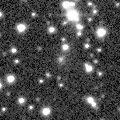
|
Now it is 16.7 mag (Oct. 25, Ken-ichi Kadota). It will pass the perihelion in 2019. However, it has not been brightening since the discovery in 2010. It is observable in good conditioin in the Northern Hemisphere. It is not observable for a long time in the Southern Hemisphere.
Date(TT) R.A. (2000) Decl. Delta r Elong. m1 Best Time(A, h)
Nov. 4 7 4.42 72 37.1 8.496 8.906 111 16.9 4:13 (180, 52)
Nov. 11 7 3.61 73 18.9 8.428 8.893 115 16.9 3:45 (180, 52)
|
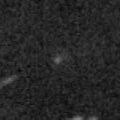
|
Now it is 18.5 mag (Oct. 21, Jonathan L. Tuten, D. Breedlove, B. Lutkenhoner). Appearing in the morning sky. It will be fading slowly after this.
Date(TT) R.A. (2000) Decl. Delta r Elong. m1 Best Time(A, h)
Nov. 4 11 18.98 -6 33.9 3.048 2.513 49 16.9 4:57 (300, 26)
Nov. 11 11 26.96 -7 36.8 3.028 2.570 53 17.0 5:03 (305, 29)
|
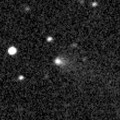
|
First return of a new periodic comet discovered in 2000. Now it is 15.9 mag (Oct. 29, Catalina Sky Survey). Although it has been brightening even after the perihelion passage, it will be fading after this.
Date(TT) R.A. (2000) Decl. Delta r Elong. m1 Best Time(A, h)
Nov. 4 0 28.63 -3 20.2 1.919 2.778 143 16.9 21:33 ( 0, 52)
Nov. 11 0 26.20 -2 25.0 2.001 2.802 136 17.2 21:03 ( 0, 53)
|

|
Now it is 16.6 mag (Sept. 16, P. Camilleri, H. Williams). It will brighten up to 14 mag from autumn to winter in 2018, and it will be observable in excellent condition in the Northern Hemisphere. In 2017, it is observable at 17 mag in excellent condition in the Southern Hemisphere.
Date(TT) R.A. (2000) Decl. Delta r Elong. m1 Best Time(A, h)
Nov. 4 22 59.93 -41 8.0 3.324 3.701 104 17.1 20:05 ( 0, 14)
Nov. 11 22 57.55 -39 45.0 3.369 3.658 99 17.1 19:35 ( 0, 15)
|
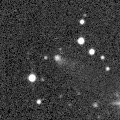
|
Now it is 18.1 mag (Oct. 25, D. Buczynski). It is observable in good condition in the Northern Hemisphere. It locates very low in the Southern Hemisphere.
Date(TT) R.A. (2000) Decl. Delta r Elong. m1 Best Time(A, h)
Nov. 4 7 27.58 34 43.4 2.569 3.089 112 17.1 4:35 ( 0, 90)
Nov. 11 7 28.76 35 5.7 2.508 3.113 119 17.1 4:09 (180, 90)
|

|
Now it is 17.3 mag (Oct. 22, C. Rinner, F. Kugel). It will brighten up to 9 mag in 2018 summer. However, it is hardly observable when it is bright. In the Northern Hemisphere, it is observable only until March when it brightens up to 14 mag. In the Southern Hemisphere, it is observable from July to September in 2018, but it locates in extremely low.
Date(TT) R.A. (2000) Decl. Delta r Elong. m1 Best Time(A, h)
Nov. 4 21 27.77 75 55.7 3.368 3.793 107 17.4 18:32 (180, 49)
Nov. 11 21 31.03 73 53.0 3.281 3.716 108 17.3 18:24 (178, 51)
|
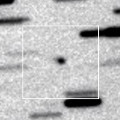
|
Now it is 16.6 mag (Oct. 26, Yuji Ohshima). It stays observable at 18 mag for a long time until 2019.
Date(TT) R.A. (2000) Decl. Delta r Elong. m1 Best Time(A, h)
Nov. 4 6 56.57 19 49.7 7.485 8.002 118 17.9 4:04 ( 0, 75)
Nov. 11 6 52.66 19 37.8 7.373 7.996 126 17.9 3:33 ( 0, 75)
|

|
Possible first interstellar object in the history. It approached to Sun down to 0.25 a.u. on Sept. 9. Now it is fading rapidly. It was 19.0 mag in mid October (Oct. 14, Catalina Sky Survey). But it has already fade down to 22.4 mag (Oct. 30, W. H. Ryan, E. V. Ryan).
Date(TT) R.A. (2000) Decl. Delta r Elong. m1 Best Time(A, h)
Nov. 4 23 31.42 5 37.7 0.740 1.595 133 23.4 20:35 ( 0, 61)
Nov. 11 23 21.77 6 1.0 0.993 1.755 124 24.2 19:59 ( 0, 61)
|
|
![]()
 188P/LINEAR-Mueller
188P/LINEAR-Mueller C/2017 T3 ( ATLAS )
C/2017 T3 ( ATLAS ) C/2015 XY1 ( Lemmon )
C/2015 XY1 ( Lemmon ) A/2017 U1
A/2017 U1![]()







































